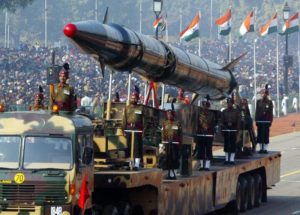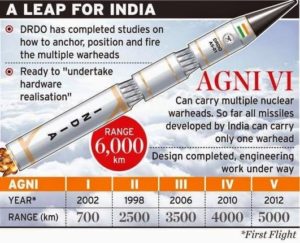The Agni Series of ballistic missiles are developed under the Integrated Guided Missile Development Programme of the Defence Research and Development Organisation of India.
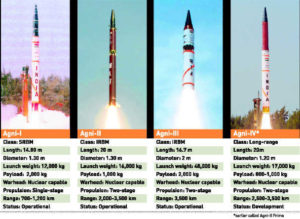 The Agni missile family consists of three variants which are already in service. The Agni-I, Agni-II and Agni-III are in service with the Indian Army. Agni-IV, series of missiles, has completed all trials successfully by January 2017. A new intercontinental ballistic missile named, the Agni-V, is also under development and is expected to enter service by 2017-18. Agni-V would also carry MIRV (Multiple Independently Targetable Re-entry Vehicles) payloads being concurrently developed. A single MIRV equipped missile can deliver multiple warheads at different targets.
The Agni missile family consists of three variants which are already in service. The Agni-I, Agni-II and Agni-III are in service with the Indian Army. Agni-IV, series of missiles, has completed all trials successfully by January 2017. A new intercontinental ballistic missile named, the Agni-V, is also under development and is expected to enter service by 2017-18. Agni-V would also carry MIRV (Multiple Independently Targetable Re-entry Vehicles) payloads being concurrently developed. A single MIRV equipped missile can deliver multiple warheads at different targets.
Agni-I Short-Range Ballistic Missile
The Agni-I is a short or intermediate-range ballistic missile. It was first tested in May 1989 at the interim test range in Chandipur off the coast of Orissa, India.
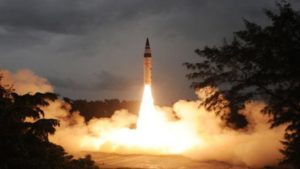 The missile consists of a single engine. In March 2010, a nuclear-capable Agni-I was test fired from the integrated test range at Wheeler Island off the Orissa coast.
The missile consists of a single engine. In March 2010, a nuclear-capable Agni-I was test fired from the integrated test range at Wheeler Island off the Orissa coast.
They are claimed to be a part of the “Minimum credible deterrence”. Agni-I is a single stage, solid fuel, road and rail mobile, short-range ballistic missile (SRBM). The need for the Agni-I was felt after the Kargil war with Pakistan.
The strap-down inertial navigation system uses an explicit guidance method. The structure is made of all-carbon composite materials to protect the payload during its re-entry stage. The flight trials proved the long-range capabilities of the missile. The missile can carry a conventional payload of 1,000kg or a nuclear warhead and has a range between 700km and 800km. These are transported by rail and road, and powered by solid propellants.
Agni-II Medium-Range Ballistic Missile
The Agni-II is a medium-range ballistic missile equipped with two solid fuel stages. It was test fired in April 1999 from the IC-4 pad. The nuclear-capable Agni-II was tested by a special strategic command force in May 2010. The missile has a range of more than 2,000km and can reach most of the western, central and southern parts of China and all of Pakistan. A tank missile with top-attack, fire and forget capability was also inducted into service.
The Agni-II is always in a ready-to-fire mode and can be launched within 15 minutes.Tested to range of over 2,000 km, the Agni-II has an all-solid propellant system. On 17 January test, the missile was alleged to have covered a range of over 2,100 km with a 700 kg warhead. The Agni-II is designed to be launched from a rail-mobile launcher, but it is also available in road-mobile configuration. This lends flexibility and reduces vulnerability to first strike.
Agni-III Intermediate Range Ballistic Missile
The Agni-III after continuous testing and development was inducted into service after May 2008, having proved the operational readiness of the missile. With a circular error probable under a 40m range, the missile is considered one of the most accurate strategic ballistic missiles of its range class in the world.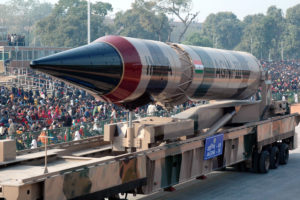
Agni III was developed as the successor to Agni-II. Designed by the Indian government’s Defence Research and Development Organisation, Agni III is a two-stage ballistic missile that is capable of nuclear weapons delivery. It was designed and developed by the Advanced Systems Laboratory (ASL), a unit of DRDO.
The two-stage ballistic missile has a diameter of 2m. The first-stage booster weighs around 32 tonnes and is made using advanced carbon composite materials, while the second-stage booster weighs 11 tonnes and is made of iron-based steel alloy. The missile can support a series of warhead configurations and a total payload of 2,490kg for a range of 4,500km.
Agni-IV Intermediate Range Ballistic Missile
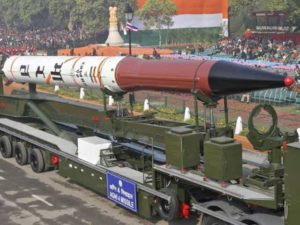 Agni-IV is a two-stage nuclear-capable intermediate range ballistic missile. The missile was first tested in November 2011 from Wheeler Island. It rose to an altitude of 900km during the test. It was successfully test-fired again in September 2012. It reached an altitude of 850km during its third test in January 2014. The missile was also successfully test-fired in January 2017.
Agni-IV is a two-stage nuclear-capable intermediate range ballistic missile. The missile was first tested in November 2011 from Wheeler Island. It rose to an altitude of 900km during the test. It was successfully test-fired again in September 2012. It reached an altitude of 850km during its third test in January 2014. The missile was also successfully test-fired in January 2017.
This missile is one of its kinds, proving many new technologies for the first time, and represents a quantum leap in terms of missile technology. The Missile is lighter in weight and has two stages of Solid Propulsion and a Payload with Re-entry heat shield. The Composite Rocket Motor which has been used for the first time has given excellent performance. The Missile System is equipped with modern and compact Avionics with Redundancy to provide high level of reliability. The indigenous Ring Laser Gyros based high accuracy INS (RINS) and Micro Navigation System (MINGS) complementing each other in redundant mode have been successfully flown in guidance mode for the first time. The high performance onboard computer with distributed Avionics architecture, high speed reliable communication bus and a full Digital Control System have controlled and guided the Missile to the target.
The Agni-IV has a length of 20 mts and weight of 17 tonnes. It can carry a payload of 800kg. The maximum range of the missile is 4,000km.
Agni-V Intercontinental Ballistic Missile
Agni-V is an intercontinental ballistic missile developed by the Defence Research and Development Organisation (DRDO) of India. Agni V is part of the Agni series of missiles, one of the missile systems under the original Integrated Guided Missile Development Program.
A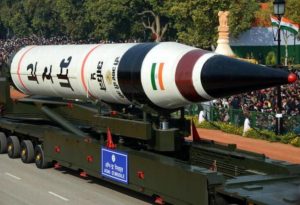 gni V as a missile with a range of 5,500–5,800 km. Agni V is primarily for enhancing India’s nuclear deterrence against China.
gni V as a missile with a range of 5,500–5,800 km. Agni V is primarily for enhancing India’s nuclear deterrence against China.
Indian authorities believed that the solid-fuelled Agni-V is more than adequate to meet current threat perceptions and security concerns. Even with a range of only 5,000 km, the Agni-V could hit any target in China, including Beijing. The missile will allow India to strike targets across Asia and into Europe. The missile’s range will allow the Indian military to target all of China from Agni-5 bases in central and southern India, further away from China. The missile was designed to be easy to transport by road through the utilisation of a canister-launch missile system which is distinct from those of the earlier Agni missiles. Agni-V would also carry MIRV (multiple independently targetable re-entry vehicles) payloads being concurrently developed. A single MIRV equipped missile can deliver multiple warheads at different targets.
The Agni-V is a three-stage solid fuelled missile with composite motor casing in the second and third stage. In many aspects, the Agni-5 carries forward the Agni-3 pedigree. With composites used extensively to reduce weight, and a third stage added on (the Agni-3 was a two-stage missile), the Agni-5 can fly significantly more to inter-continental range.
Agni-VI Intercontinental Ballistic Missile
Agni-VI will be a four-stage intercontinental ballistic missile, which is in the hardware development phase, after its design phase was completed. Agni-VI is expected to have Multiple independently targetable reentry vehicle as well as Maneuverable reentry vehicle(MaRV). And these maneuverable warheads will give Agni VI an extended range exact figure of which is currently classified. It will be taller than its predecessor Agni V, and was expected to be flight tested by 2017. The government of India is yet to approve the project, although DRDO has completed all calculations and started the engineering work.
It is reported to be the latest and most advanced version among the Agni missiles. According to sources, Agni-VI missile is likely to carry up to 10 MIRV warheads and will have a strike range of 8,000 km to 12,000 km, though DRDO has refused to confirm the missile’s range.A senior DRDO scientist was quoted as saying that the new generation Agni-VI missile will be sleeker, easily transportable and would be readily deployed. It will have the capability to be launched from submarine and from land-based launchers.
AGNI SERIES and GLOBAL REACH
You may also like
-
IAF Aircraft Set Course For Exercise Eastern Bridge VII At Oman
-
IAF Set To Host The Indian Defence Aviation Exposition-II At Jodhpur
-
Defence Secretary to co-chair 5th India-Philippines Joint Defence Cooperation Committee meeting in Manila
-
Simultaneous Launch Of ‘malpe And Mulki’, Fourth And Fifth Ships Of Asw Swc (Csl) Project
-
Aatmanirbharta in Defence: MoD signs Contract with HAL for 240 AL-31FP Aero Engines for Su-30MKI Aircraft

